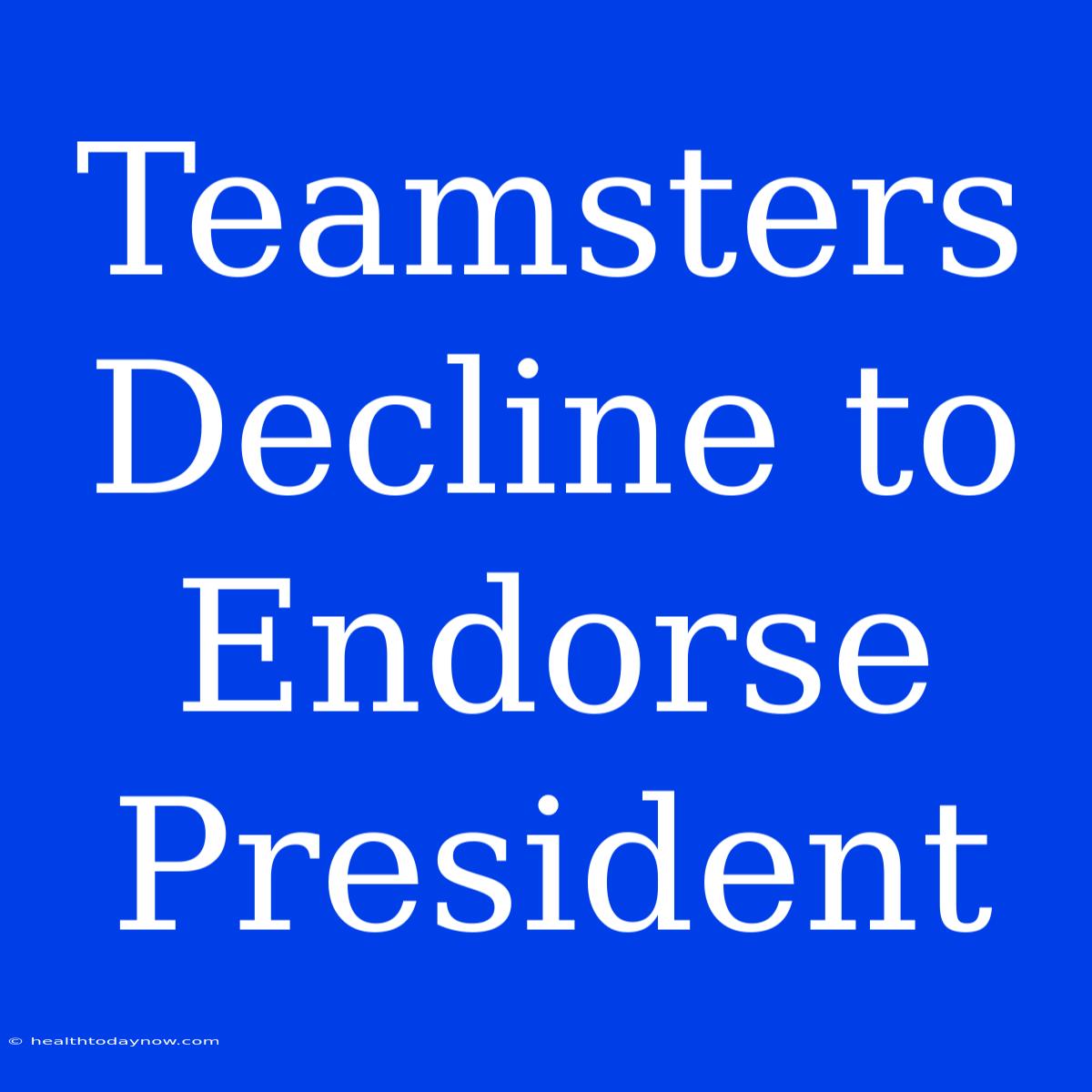Teamsters Decline to Endorse President: A Major Setback or Strategic Move?
The Teamsters Union, a powerful force in American labor, has declined to endorse a presidential candidate for the first time in decades. This decision has sent shockwaves through political circles, sparking questions about the union's future role in elections and the potential impact on the upcoming presidential race.
Editor Note: The Teamsters' decision not to endorse a president is a significant development, as the union has historically wielded considerable influence in elections. This move signals a shift in the union's political strategy, potentially impacting both the Democratic and Republican parties.
Why this is important: The Teamsters represent over 1.4 million workers across various industries, including trucking, warehousing, and airlines. Their endorsement has traditionally been seen as a major boost for candidates, particularly in key swing states. This year, the union's decision not to endorse could have a significant impact on the outcome of the election, especially in close races.
Our analysis delves into the factors behind the Teamsters' decision, examining the union's internal dynamics, its evolving relationship with both political parties, and the changing landscape of labor politics. We analyze the potential implications of this decision on the presidential race, focusing on key battleground states and the potential for a shift in voter sentiment.
Key Takeaways of Teamsters' Decision
| Key Takeaway | Explanation |
|---|---|
| Shift in Political Strategy: The Teamsters are emphasizing their focus on grassroots organizing and member engagement rather than traditional endorsements. | This signals a move away from top-down political engagement towards a more decentralized approach. |
| Growing Dissatisfaction with Both Parties: The union's decision reflects the growing dissatisfaction among labor groups with both the Democratic and Republican parties' stances on issues like labor rights and economic inequality. | This suggests a broader shift in labor politics, with unions looking beyond traditional party alliances. |
| Focus on Local Issues: The Teamsters are prioritizing local campaigns and candidate endorsements that directly impact their members' daily lives and working conditions. | This approach emphasizes the union's focus on practical, tangible issues rather than broader ideological platforms. |
Understanding the Teamsters' Decision
The Teamsters' Decision:
- Internal Dynamics: The decision not to endorse a presidential candidate reflects internal divisions within the union, with some members advocating for a more active political role and others prioritizing grassroots organizing.
- Evolving Relationship with Political Parties: The union's relationship with both the Democratic and Republican parties has become increasingly strained in recent years, due to perceived failures on issues like labor rights and economic inequality.
- Changing Landscape of Labor Politics: The rise of independent labor groups and the growing awareness of issues like gig work and automation have shifted the landscape of labor politics, prompting the Teamsters to reassess their traditional political strategies.
Impact on the Presidential Race:
- Swing State Implications: The Teamsters' decision could impact key swing states, potentially reducing the influence of labor unions in these crucial races.
- Voter Sentiment: The union's decision to prioritize local issues could resonate with voters who are increasingly disillusioned with traditional party politics.
- Potential for a Shift in Labor Politics: The Teamsters' decision could signal a broader shift in labor politics, with unions becoming more independent and focused on grassroots organizing and local issues.
Conclusion
The Teamsters' decision not to endorse a presidential candidate marks a significant turning point in American labor politics. This move signals a shift in the union's political strategy, emphasizing grassroots organizing and local issues over traditional endorsements. While the impact on the presidential race remains unclear, this decision highlights the growing dissatisfaction among labor groups with both political parties and the evolving landscape of labor politics.
FAQs about Teamsters' Decision:
Q: Why did the Teamsters decide not to endorse a president?
A: The union cited internal divisions, growing dissatisfaction with both parties, and a desire to focus on local issues as reasons for their decision.
Q: How will this decision impact the presidential race?
A: It could impact swing states and voter sentiment, potentially influencing the outcome of the election.
Q: What does this decision mean for the future of labor politics?
A: It could signal a shift towards a more independent and grassroots approach to labor politics, with unions focusing on local issues and mobilizing members at the local level.
Tips for Understanding the Teamsters' Decision:
- Stay Informed: Follow news and analysis from reliable sources to stay up-to-date on the latest developments related to the Teamsters and labor politics.
- Engage with Local Issues: Learn about the issues that affect your local community and consider ways to get involved in local campaigns.
- Support Labor Organizations: Consider joining a labor union or supporting organizations that advocate for workers' rights.
Summary of Teamsters' Decision
The Teamsters' decision not to endorse a presidential candidate signifies a significant departure from their traditional political strategy. It reflects internal divisions, dissatisfaction with both political parties, and a growing emphasis on grassroots organizing and local issues. This decision could have a ripple effect on the upcoming presidential election, potentially influencing voter sentiment and the outcome of key swing states.
Closing Message
The Teamsters' decision represents a turning point in American labor politics. It signals a growing disconnect between labor unions and traditional political parties, along with a shift towards more independent and grassroots organizing. As the political landscape continues to evolve, it will be crucial to monitor the role of labor unions and their impact on elections and policy decisions.

